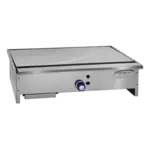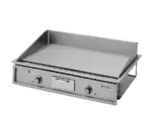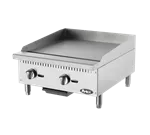
Griddle Vs Grill: What's the Difference?
Having the right equipment for the job makes all the difference when it comes to cooking. Grills and griddles are two of the most versatile cooking appliances for home and commercial kitchens. But what is the difference between a griddle and a grill, and how do you know which option is better for your cooking needs?
In this article, we will break down the pros and cons of griddles vs. grills, the different types available, what foods are best cooked on each, and how to decide which is the superior cooking surface for your restaurant or catering business.
What is a Griddle?
A commercial griddle is a flat cooking surface, usually made of cast iron or steel, that is heated from below and is used to cook food quickly over direct heat. The flat surface provides even heating over a large area, making cooking items like pancakes, eggs, burgers, grilled sandwiches, and more easy.
Conversely, griddles can cook large batches of food simultaneously, making them a workhorse for busy commercial kitchens. The flat surface also allows for easy flipping and movement of food during the cooking process. Griddles can be standalone units placed over a range burner or grill, built-in to a countertop, or even portable electric units.
Types of Griddles
There are a few different types of commercial griddles commonly used in restaurants and food service operations, including:

Insert Griddles
Insert griddles are designed to fit into a cutout space of a countertop, letting them sit flush with the surrounding surface. This style is common in diners and breakfast restaurants that prepare eggs and other griddled foods.
In addition, Insert griddles are easy to install and remove. They simply fit into the stove openings and are held in place. They can be taken out when not needed to maximize the workspace. This flexibility allows kitchens to use griddles for peak periods and remove them for slower times.
Freestanding Griddles
These are complete units that sit on legs rather than being built-in. Since they have built-in legs, freestanding griddles can be wheeled from station to station. This is convenient when multiple chefs need access to the griddle.
Their mobility, versatility, and ease of use promote efficiency in fast-paced kitchens. However, their heat output may not match dedicated stovetops. Still, for tasks where precise temperature control is less critical, freestanding griddles provide an option for restaurants seeking flexibility and fast preparation.
Tabletop Griddles
Portable electric griddles can sit right on the countertop or prep station surface. These are ideal for catering, food trucks, outdoor events, or anywhere that does not have a built-in cooking surface. Most tabletop griddles are relatively small but perfect for cooking in batches.
Their integrated temperature controls and fast heat-up times also promote productivity. For tasks that do not require a large griddle surface, tabletop models provide an easy-to-use and stable option for commercial kitchens. However, their more compact sizes mean they generally have a lower maximum cooking capacity.
What Can You Cook on a Griddle?
From pancakes and eggs for breakfast to meat, vegetables, and desserts, the direct heat and flat surface make griddles perfect for cooking numerous dishes.

Breakfast Foods
Griddles are commonly used in cooking breakfast favorites like pancakes, French toast, and eggs. Pancakes and French toast cook evenly when made multiple times on a griddle. The flat top allows the batter to spread out while cooking without sticking. Scrambled eggs, fried eggs, and omelets cook well on a griddle. The high heat ensures the eggs cook properly and quickly.
Meats and Vegetables
Meat and seafood can be grilled directly on a griddle. Options include bacon, sausage patties or links, hamburgers, chicken breasts or tenders, fish fillets, and steak. After preheating the griddle, the meat can be laid on the surface and cooked until browned and cooked through, flipping halfway. Vegetables like sliced zucchini, yellow squash, bell peppers, and mushrooms also work well when cooked on a griddle. Their moisture helps prevent sticking while allowing them to become lightly caramelized.
Desserts
Although less common, a griddle can even be used to cook light desserts. Many of the same foods cooked for breakfast, like pancakes and French toast, can be made in more fancy dessert versions on a griddle. Dessert crepes, panini sandwiches with Nutella or jelly filling, layered fruit crisps, and toasted sandwiches like peanut butter and banana can also be made using a griddle.
What is a Grill?
A grill is another popular cooking appliance that provides direct heat from below but uses a grated or grooved surface rather than a flat cooking plane. Grills can use charcoal, gas, or electricity as their heat source.
The gaps between grill grates allow grease and fat to drip away from foods while providing distinct sear marks and a smoky, charred flavor. The ridges also prevent smaller or more delicate foods from falling through. Grilling gives off a distinctive smoky taste that can’t quite be replicated on a flat griddle.
Types of Grills
Commercial grills come in a few standard types and varieties, including:

Charcoal Grill
The traditional grilling choice, charcoal grills, uses burning charcoal briquettes as the heat source. Charcoal grills require time to heat up but provide an authentic barbecue flavor from the charcoal. They also allow custom heat control by adjusting air vents and moving coals.
Gas Grill
Gas grills are fueled by propane or natural gas, providing greater convenience than charcoal. They heat up more quickly and can easily turn on or off with a knob. Gas grills are excellent for consistent and even heat.
Electric Grill
Electric grills offer indoor convenience, plugging into an electric outlet to deliver heat to the grilling surface. They provide a similar convenience to gas grills and are a great option for indoor grilling when using an open flame or charcoal is not practical.
What to Cook on a Grill
Grilled items are often crowd-pleasing options on restaurant menus. Grills’ capacity for high-heat, high-volume cooking enables chefs to prepare various starters, mains, and desserts for their menus.

Appetizers and Starters
Grill chefs often turn to classics like skewers, flatbreads, and calamari. Shrimp, chicken, and vegetable skewers marinated in teriyaki or chili garlic sauce can be perfectly grilled. In addition, naan and pita flatbreads baked on grill presses can be served alongside delicious dips.
Main Dishes
The large flat tops and powerful gas or electric heating sources mean grills are ideally suited to cooking restaurant mains. Thick-cut steaks like porterhouse cook perfectly, as do large bone-in pork and lamb chops. In addition, rotisserie chicken and turkey provide an economical protein option, while bone-in chicken pieces support higher-end menus.
Desserts
The high heat, large surface area, and precise temperature control of commercial grills enable chefs to grill a variety of sweet treats. For instance, skewered fresh fruit such as pineapple wedges and halved strawberries make for a colorful and fresh dessert. Grill the kabobs to caramelize the natural fruit sugars, then dip them in chocolate or caramel sauce for an extra layer of flavor and texture.
Grill vs Griddle: Which is Better for Your Business?
So when choosing cooking equipment for your commercial kitchen, should you choose a griddle or a grill? Here are some factors to help you decide:
Cooking Volume
- Grills: Cook fewer items at once. You must stagger cooking times and flip foods individually.
- Griddles: Cook higher volumes simultaneously. Multiple items can fit on a wide, flat surface.
Types of Food
- Grills: Better suited to meats, kabobs, and some vegetables that benefit from smoky char.
- Griddles: Excel at flat proteins, sandwiches, breakfast items, and sliced or diced vegetables.
Flavor
- Grills: Impart a distinctive smoky, charred flavor.
- Griddles: Produce a more neutral, browned flavor through conduction heat.
Ease of Use
- Grills: Require more oversight and manual flipping or rotating of foods.
- Griddles: Need less supervision once foods are placed as items and self-release when done.
A griddle is likely the better investment if your business is focused on American breakfast foods, sandwiches, and diner fare. For a steakhouse or barbecue restaurant, a versatile grill is ideal. In addition, combining a griddle for base components and a grill for signature items maximizes versatility. Ultimately, your business goals, menu, and kitchen space will determine which, or both, options are right for your business.
To Wrap Up!
Whether you run a bustling diner, a catering company, or a laidback barbecue joint, your cooking surface impacts the dishes you serve. Griddles and grills each have their advantages for different cooking needs. Griddles excel at large-volume cooking and delicate foods, while grills provide unmatched flavor and are the only way to get an authentic char.
Consider space, heating source, menu, and volume when deciding between a griddle and a grill. Many commercial kitchens benefit from having both. With the right cooking surface, you can broaden your menu and deliver outstanding results. Find the equipment that unlocks your chef’s potential, and get ready to impress!
FAQ
Is cooking on a griddle better than grill?
Griddles provide more even cooking across a larger surface area. This makes them preferable for cooking large batches of foods like eggs, pancakes, and sandwiches. However, grills give food a nice char and smoky flavor. Grills are better for meats that benefit from searing, like steaks and burgers.
Are steaks better on a grill or griddle?
Grilling is better than cooking on a griddle for the ideal steak texture and flavor. The ridges on a grill allow the meat to char while the open flame imparts a lovely smoky taste. Griddles can be used to cook steaks through more gently without charring the exterior. However, for the classic steakhouse experience, grills can’t be beaten.
Is a griddle healthier than a grill?
Cooking on a griddle is generally healthier than grilling. Griddles allow excess grease and fat to cook off foods rather than dripping onto an open flame like with grilling. Griddle cooking avoids the charring that can produce harmful compounds when fat drips onto the fire. Food cooked on a griddle also retains more moisture versus the drier results from grilling. Overall, griddle cooking is lower in fat and provides more control.
What are the sizes of griddles?
Griddles come in a wide range of sizes to suit different kitchens and applications:
- Small (9x12 inches to 12x15 inches): These compact griddles are good for making a few pancakes, eggs, or small sandwiches at a time. They are suitable for small cafes.
- Medium (15x20 inches to 18x26 inches): Medium griddles can cook for 2-4 people at once. They are good for making several pancakes, eggs, paninis, and small batches of French fries. Medium griddles work well for most small commercial kitchens.
- Large (20x32 inches to 36x60 inches): Large griddle surfaces can cook for eight or more people at once. They are suited for commercial kitchens like diners and restaurants making breakfast sandwiches, pancakes, and high-volume grill items.



